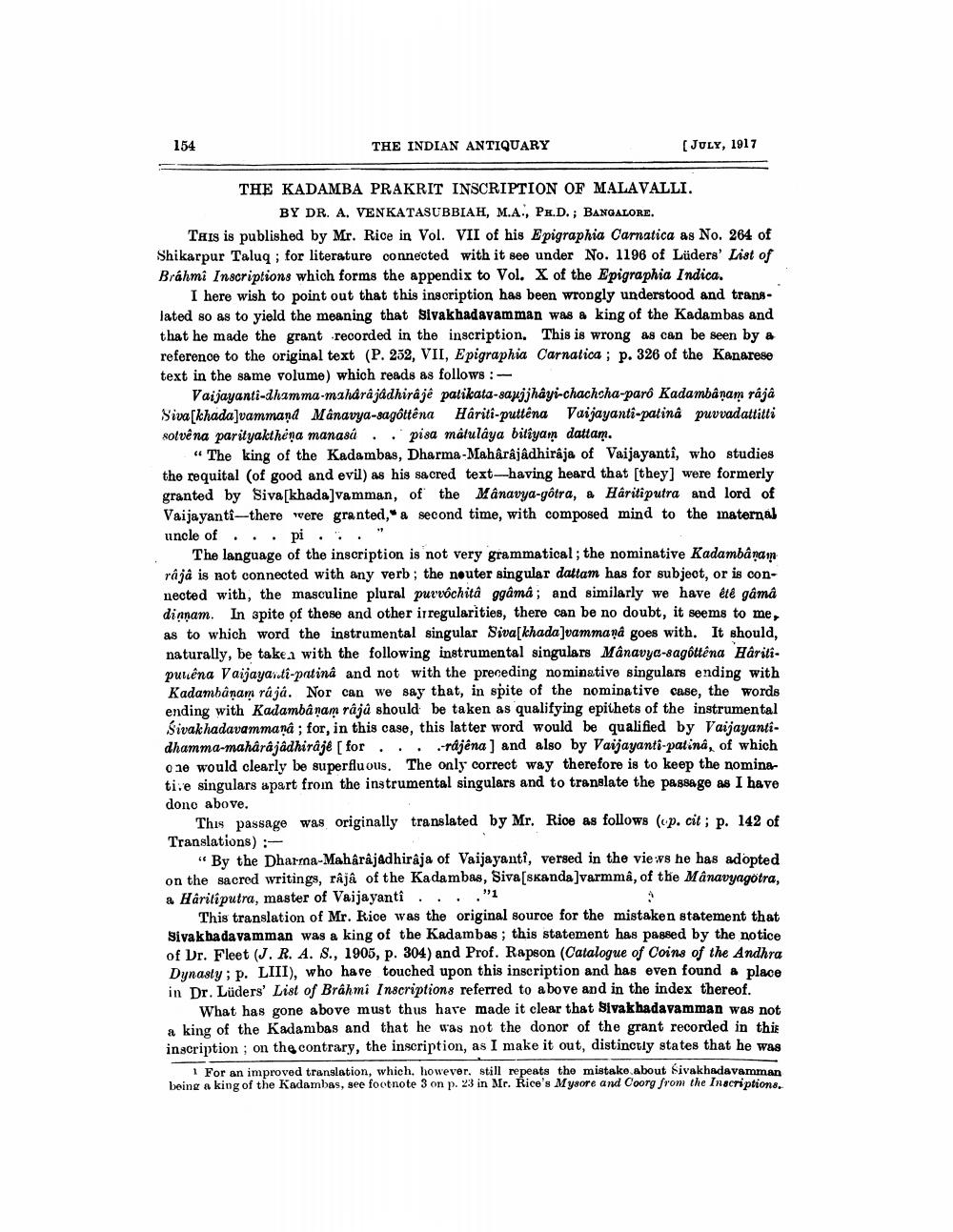________________
154
THE INDIAN ANTIQUARY
[JULY, 1917
THE KADAMBA PRAKRIT INSCRIPTION OF MALAVALLI. BY DR. A. VENKATASUBBIAH, M.A., PH.D.; BANGALORE.
THIS is published by Mr. Rice in Vol. VII of his Epigraphia Carnatica as No. 264 of Shikarpur Taluq ; for literature connected with it see under No. 1196 of Lüders' List of Brahmi Inscriptions which forms the appendix to Vol. X of the Epigraphia Indica.
I here wish to point out that this inscription has been wrongly understood and translated so as to yield the meaning that Sivakhadavamman was a king of the Kadambas and that he made the grant recorded in the inscription. This is wrong as can be seen by a reference to the original text (P. 252, VII, Epigraphia Carnatica; p. 326 of the Kanarese text in the same volume) which reads as follows:
Vaijayanti-dhamma-mahārājādhirājë patikata-sapjjhâyi-chachcha-paró Kadambāṇamı rājā Siva[khada]vammad Minavya-sagdtina Häriti-puttina Vaijayanti-patiná puvvadattitti sotvena parityakthena manasu pisa matulâya bitiyam dattam.
"The king of the Kadambas, Dharma-Mahârâjâdhirâja of Vaijayanti, who studies the requital (of good and evil) as his sacred text-having heard that [they] were formerly granted by Siva [khada]vamman, of the Mânavya-gôtra, a Hâritiputra and lord of Vaijayanti-there were granted, a second time, with composed mind to the maternal uncle of... pi...
The language of the inscription is not very grammatical; the nominative Kadambânam rajâ is not connected with any verb; the neuter singular dattam has for subject, or is connected with, the masculine plural puvvôchitâ ggâmâ; and similarly we have été gâmâ dianam. In spite of these and other irregularities, there can be no doubt, it seems to me, as to which word the instrumental singular Siva[khada]vammanâ goes with. It should, naturally, be taken with the following instrumental singulars Mânavya-sagôttêna Hâritipuêna Vaijayanti-patinâ and not with the preceding nominative singulars ending with Kadambanam rújá. Nor can we say that, in spite of the nominative case, the words ending with Kadambânam râjú should be taken as qualifying epithets of the instrumental Sivakhadavammanâ; for, in this case, this latter word would be qualified by Vaijayantidhamma-mahârâjâdhirâje [ for ... rájêna] and also by Vaijayanti-patina, of which one would clearly be superfluous. The only correct way therefore is to keep the nominative singulars apart from the instrumental singulars and to translate the passage as I have done above.
This passage was originally translated by Mr. Rice as follows (op. cit; p. 142 of Translations) :
"By the Dharma-Mahârâjadhiraja of Vaijayanti, versed in the views he has adopted on the sacred writings, râjâ of the Kadambas, Siva [skanda]varmmâ, of the Mânavyagötra, a Hâritiputra, master of Vaijayantî...."1
This translation of Mr. Rice was the original source for the mistaken statement that Sivakhada vamman was a king of the Kadambas; this statement has passed by the notice of Dr. Fleet (J. R. A. S., 1905, p. 304) and Prof. Rapson (Catalogue of Coins of the Andhra Dynasty; p. LIII), who have touched upon this inscription and has even found a place in Dr. Lüders' List of Brahmi Inscriptions referred to above and in the index thereof.
What has gone above must thus have made it clear that Sivakhadavamman was not a king of the Kadambas and that he was not the donor of the grant recorded in this inscription; on the contrary, the inscription, as I make it out, distinctly states that he was
1 For an improved translation, which, however, still repeats the mistake about Sivakhadavamman being a king of the Kadambas, see footnote 3 on p. 23 in Mr. Rice's Mysore and Coorg from the Inscriptions.




